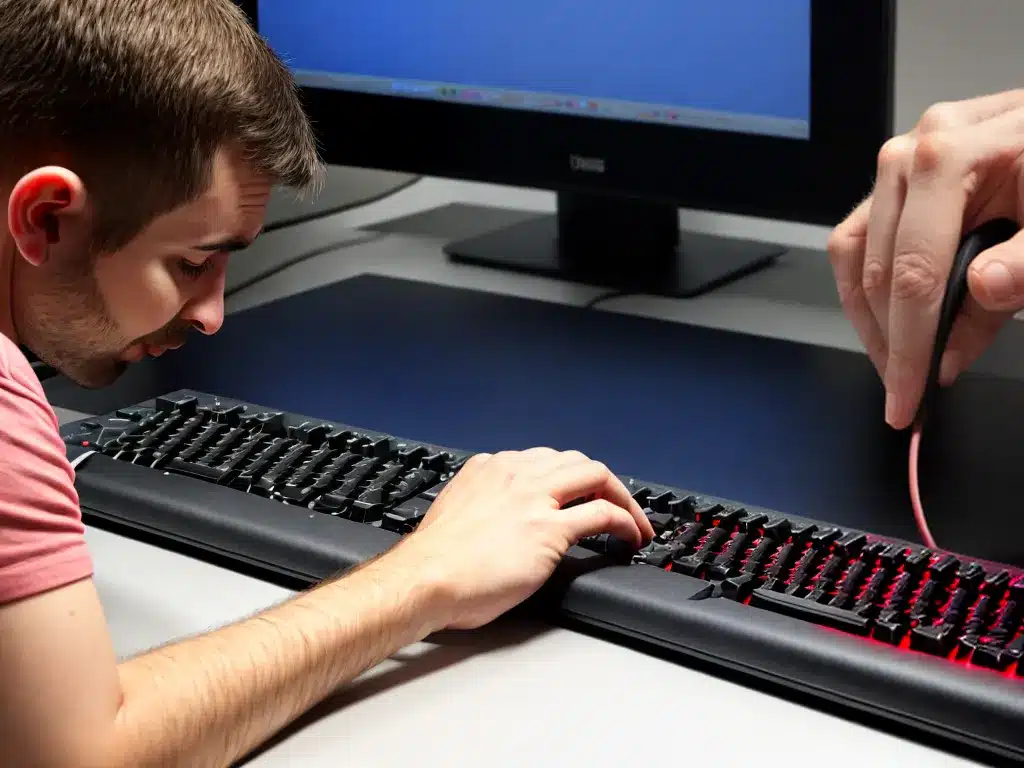
Introduction
As a computer user, having a properly functioning mouse and keyboard is essential for productivity and enjoyment. However, these devices can sometimes develop issues that prevent them from working properly. The good news is that most mouse and keyboard problems can be resolved with some basic troubleshooting. In this article, I will provide an in-depth guide on how to troubleshoot and fix common mouse and keyboard problems.
Check Physical Connections
The first step when troubleshooting mouse or keyboard issues is to check the physical connections. Here are some things to check:
-
Make sure the device is plugged in properly. Loose connections can interrupt the flow of data. Unplug the device and plug it back in to ensure a tight connection.
-
Check the cable for damage. Frayed or cut cables will not transmit data correctly. Inspect the length of the cable for any damage. Replace damaged cables.
-
Try plugging the device into another USB port. Perhaps the port itself is malfunctioning, not the device. Test other available USB ports.
-
Consider using a USB hub. If you have several USB devices connected, there may not be enough power for all the devices. A powered USB hub resolves this issue.
-
Test the device on another computer. This helps determine whether the issue is with the device itself or a problem with the computer.
Update Drivers
Outdated, corrupted, or missing drivers can cause mouse and keyboard problems. Here’s how to update drivers:
-
For Windows: Open Device Manager, expand the “Mice and other pointing devices” and “Keyboards” sections, right-click the device and select “Update driver.”
-
For Mac: Open System Preferences > Keyboard and Mouse. Click on the device and then on Update Drivers.
-
Get drivers from manufacturer’s website. If updates are not available through the OS, get the latest drivers from the device manufacturer’s website.
Updating drivers will often fix mouse and keyboard problems related to software and connectivity.
Check for Interference and Obstacles
Wireless mice and keyboards connect via a USB dongle. Objects between the devices can disrupt the signal:
-
Adjust positioning. Make sure the line of sight between the devices is clear. Remove any objects blocking the signal path.
-
Check distance. Most wireless devices work up to 10 meters or 30 feet. Move devices closer if malfunctioning.
-
Switch channels. Some wireless devices let you switch transmission channels to avoid interference. Try a different channel.
-
Use a signal extender. Products like wireless USB hubs extend the range for wireless devices. Place the hub halfway between computer and device.
Adjust Mouse Settings
For mouse-specific issues like slow response or jumping cursor:
-
Adjust mouse speed. Faster response can resolve lag issues. Slower speeds help stabilize a jumping cursor. Adjust in mouse settings.
-
Toggle enhanced pointer precision. This feature makes the mouse accelerate when moving quickly. Turn off if experiencing inconsistent movement.
-
Uncheck box to hide pointer while typing. This can cause cursor jumps when typing. Uncheck this box.
-
Change USB selective suspend setting. Suspending USB devices can lead to lag after idle periods. Disable this setting for consistent response.
-
Update touchpad drivers. If using a laptop touchpad, ensure drivers are updated through your operating system and manufacturer.
Test in Safe Mode
Booting into safe mode starts your computer with only essential drivers and services. This isolates potential software conflicts:
-
For Windows: Hold Shift while clicking Restart. Then select “Troubleshoot” > “Advanced options” > “Startup Settings” > “Restart” and press 4 or F4 to boot into safe mode.
-
For Mac: Restart while holding Shift. Login and open System Preferences > Startup Disk. Click Restart in safe mode.
If the devices work properly in safe mode, a third-party application is likely causing issues.
Clean the Mouse
Dirt, dust and debris on a mouse sensor or rollers can impede proper operation:
-
Optical mice: Use a cotton swab with alcohol to gently clean the “eye” of the sensor under the mouse.
-
Mechanical mice: Flip the mouse upside down. Use compressed air to blow out particles around the rollers and sensor.
-
Trackball mice: Use a cotton swab and alcohol to remove buildup from the trackball itself and socket.
Proper cleaning can restore responsiveness and precise tracking.
Keyboard Troubleshooting
For keyboard issues:
-
Check for debris under keys. Use compressed air to dislodge anything stuck under keys.
-
Replace batteries. Wireless keyboards need new batteries when input becomes inconsistent.
-
Verify keyboard layout/language. Wrong layout settings can jumble keyboard input. Set proper layout in system settings.
-
Test with external keyboard. Malfunctions may indicate a problem with the integrated keyboard itself if using a laptop.
When to Replace a Device
If you have exhausted all troubleshooting steps and the mouse or keyboard still does not function correctly, replacement is likely needed:
-
Intermittent issues: A device that works sometimes but fails unpredictably needs replacement. Intermittent issues typically stem from hardware failure.
-
Missing button functionality: Buttons or keys not registering presses indicates a hardware problem.
-
Excessive lag: Severe lag/response times over 1 second after troubleshooting often means replacement is needed.
-
Error messages: Persistent error messages about USB connectivity indicate the device hardware has failed.
Replacement mice and keyboards are inexpensive peripherals. Purchase a new device if troubleshooting does not resolve the issues.
Conclusion
With methodical troubleshooting, the majority of mouse and keyboard problems can be fixed and do not require replacement. Start with the basics like connections and cables. Update drivers, adjust settings, clean the devices, and isolate potential software conflicts. Replace any severely malfunctioning hardware if issues persist after troubleshooting. With patience and these tips, your mouse and keyboard can be restored to full working order.












